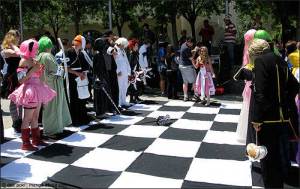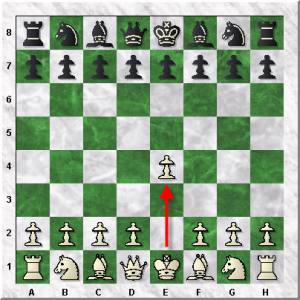Chess openings…Google it and see how many results you get. Did your computer yell at you and tell you to go climb a tree? Figured. There are hundreds upon thousands of different openings one could employ when you sit down to play chess. Some people memorize these openings like their life depended on it. Others are more free style.
*Special Tip: When setting up the board, the white square should always go in the lower right hand corner and the queen should always go on her own color.
A chess opening is a series of moves on both sides that are common or familiar. Chess openings serve as a guide to how the first five or ten moves should go. When you decide you want to browse different kinds of openings to see which one suits your fancy, you’ll run into what’s called “notation.”
Notation is a way to record the movements of each player so that entire games can be recorded. There are two main ways to notate a game.
Descriptive: Writing the first initial of the piece you are moving then writing what square you’re moving to in relation to other pieces is called descriptive notation. For example…moving the pawn forward in front of your king two spaces would be P-K4, or Pawn to King 4. “4″ represents the number of ranks or rows you’ve advanced. Your king, queen, bishops, knights, and rooks start on the first rank. Your pawns start on the second. This notation is applicable to both sides in that you would notate from your point of view, meaning if your opponent responds the same way, he would also write P-K4 and not P-K5.
Algebraic: Each square has a letter and number assigned to it. Letters horizontal, numbers vertical. From white’s point of view, A1 starts on the very left where his rook is. Black’s rook on the same row would be A8. This is different from descriptive as the point of view is the same no matter what side is moving, a square will always be A1 or A8. Moving king pawns forward two spaces on both sides would read…E2-E4, E7-E5.
With that said…chess openings.
As I mentioned before you’ll get many search results when you Google “chess openings.” There is almost an equal number of books on the subject.
You want my honest advice? I guess you would, seeing as how you made it this far in the article. Don’t kill yourself memorizing openings. Don’t waste your money buying books on openings. Don’t worry about conforming to a pre-set series of moves someone else invented.
Chess is not a game of memorization. Chess is a game of adaptation and innovation. It would be impossible…and I mean impossible, to predict what your opponent will really do on his next move despite what the obvious best move might be in your eyes. Chess openings are all fine and dandy if you both know them and follow them like good little robots. The problem is we’re not robots. All it takes is one move to throw your pre-set plan into the crapper.
I was in the United States Chess Federation in my youth and played many people who sat there reading books and stressing over the correct way to play openings. I laughed and when it came time to play them, I played whatever I felt was the best move at the time and not what some book told me to do. Watching their face fall when they realized that their master plan (on paper anyway) had fallen apart because I wasn’t responding the way they expected was priceless.
Don’t try fancy openings you will have difficulty adapting to when things don’t go the way you planned. Play at your level bracket, play smart, and play to have fun.
Click Here to return to the main article.
—



